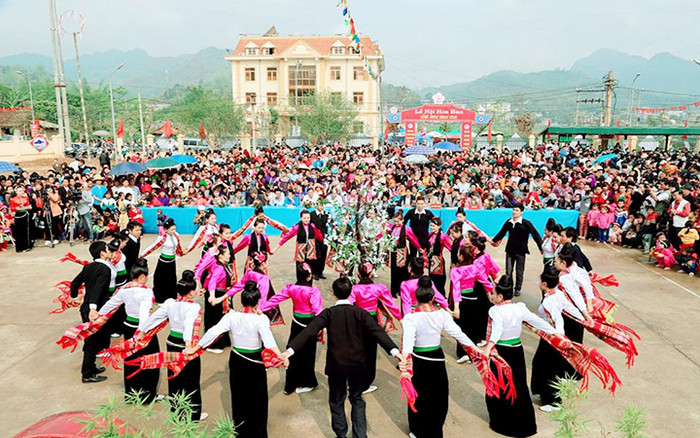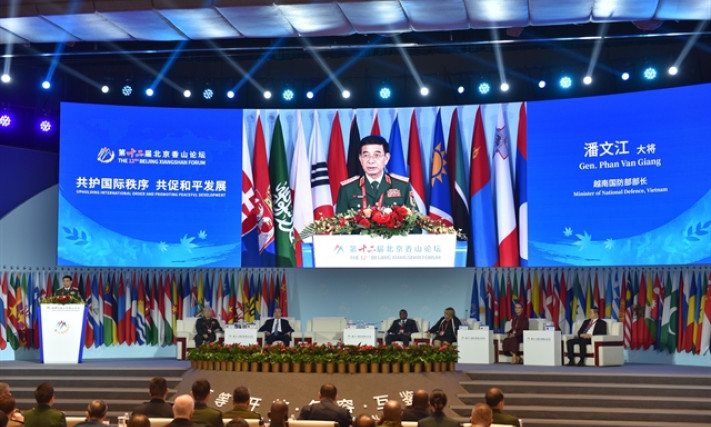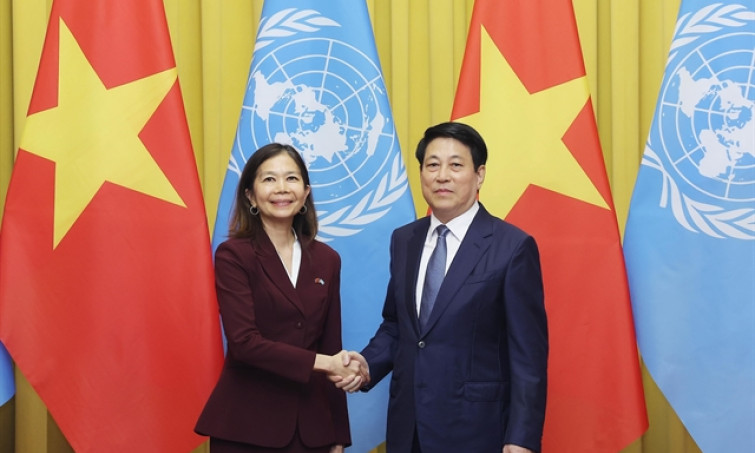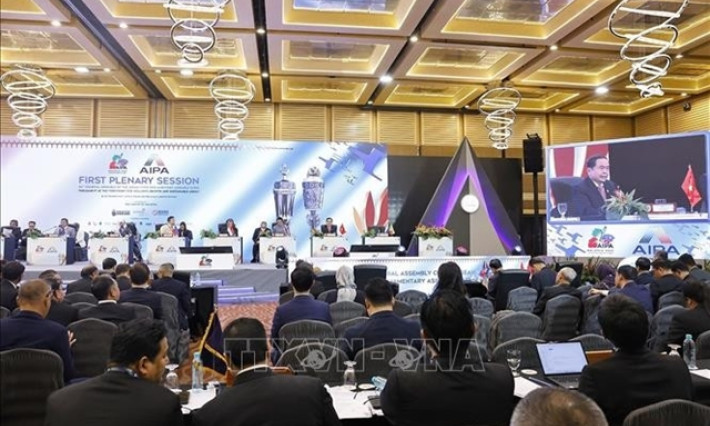Preserving and promoting Xoe Thai arts
Xoe dance has been closely associated with the customs, practices, beliefs, festivals and cultural activities of the Thai ethnic minority people in the north-western region. Xoe dance has become a thread connecting the community and expressing the ethnic groups’ identities as well as a basis for creating new cultural values.
The art of Xoe dance of the Thai ethnic minority people in Vietnam was listed by UNESCO as an Intangible Cultural Heritage of Humanity on December 15, affirming the world’s recognition of Vietnamese cultural values.
Xoe Thai, called by Thai ethnic minority people by different names, including Xe, Xek, Xoe, Xoe Dance, Then Dance and Mo. Subjects of Xoe Thai practices are both Black and White Thai people, mainly in Yen Bai, Lai chau, Dien Bien and Son La provinces. Some places considered the centres of Xoe Thai are Muong Lo (Yen Bai), Muong So and Phong Tho (Lai chau), Muong Lay and Muong Thanh (Dien Bien) and Thuan Chau (Son La). Xoe Thai has been also scattered in the provinces of Hoa Binh, Thanh Hoa and Nghe An, but it has not been as popular.
Many Thai ethnic people today do not know when the ancient Xoe dances appeared. They only knew that Xoe dances have existed since their ancestors and have been passed down through generations. Xoe has been practiced in many different spaces and times in festivals such as ceremonies to pray for villages’ peace and rains, worshipping rituals of Then village patriarch, weddings, new house celebrations and birthdays. Xoe Thai has been popularised in parties and art festivals of the community as well as the cultural, sport and tourism events of the localities, especially Phong Tho Xoe Festival in Lai Chau and Muong Lo Xoe Festival in Yen Bai. Xoe has become an indispensable ‘spiritual dish’ in the community life of Thai people in the Northwest region of Vietnam.
Many people thought that there are about 36 dances, including six ancient ones featuring an invitation to drink rice wine, dance about the four corners of the Earth, stepping up and down, tossing scarfs dance, holding hands, and clapping hands while walking in a circle. Meanwhile, researchers refer to three main types: ritual, presentational and circle Xoe. Ritual Xoe dances are often used in local festivals associated with rituals performed by shamans. Xoe movements are imitations of stylised actions that support the communication between shamans and gods. Presentational Xoe dance meets people’s demand of enjoying cultural and art performances and are usually performed by a small group. They are often named after props used during certain performances such as Xoe khan (dance with scarfs), Xoe non (dance with conical hats), Xoe quat (dance with fans), Xoe sap (dance with bamboo poles), Xoe nhac (dance with music), Xoe gay (dance with sticks), and Xoe hoa (dance with flowers). Circle Xoe is a collective dance, wherein dancers form a circle and perform in harmony. The circles can be expanded and connected flexibly. The circle Xoe dances are held at the end of festivals, fun events, birthday parties and weddings.
Xoe Thai has many unique historical, cultural, artistic and spiritual values. Firstly, Xoe Thai expressed clearly the cultural identities of the Thai ethnic minority group, from dances, music, songs, costumes and instruments. The Xoe dances accentuate traditional shirts with the sparkling silver buttons and the graceful velvet dresses of Thai ethnic girls. Musical instruments for Xoe are quite diverse such as big and small drums, gongs, Tinh (gourd lute), ken loa (traditional trumpet), khen be (Pan-pipe) and cymbals. Especially, the most unique instruments are khen be and seven types of pi. The soft and flexible dances resonate with the bustling music, colourful costumes, and the space imbued with the identity of the Thai group to make Xoe into an interesting and attractive phenomenon. Xoe practices also clearly show the cultural behaviour, hospitality and openness of the Thai people.

Xoe Thai also contributes to meeting the spiritual needs of the people in healing, praying for peace and expressing gratitude to the gods who gave them a prosperous and peaceful life, favourable winds and rain and bountiful crops, as well as helped them avoid diseases, calamities and disasters.
In modern life, Xoe Thai has an important significance in meeting the people’s needs of enjoying cultural, art and entertainment activities following hard working days.
Xoe Thai has become a “bridge” connecting and strengthening the solidarity among the community. All people, regardless of age, gender, occupation, social status, ethnic, religion and beliefs, can participate in Xoe performances. All share in the joy of the big Xoe circles. In a fun and sympathetic atmosphere, people are closer and friendlier with each other. Xoe Thai has become the beginning of the couples’ love. Many couples have the opportunity to make friends and get married after the Xoe performances. It can be seen that Xoe Thai plays an important role in community life.
Xoe heritage also contributes to creating jobs and improving income for local people through tourism exploitation activities, including cultural tourism, community-based tourism and festival-based tourism.
In addition to diversifying Thai dances and enriching the folk dancing arts of the Thai people, Xoe creates the difference in dances between Thai and other ethnic groups. Xoe Thai also helps inspire the pride among the heritage’s subjects and raise Thai ethnic minority people’s awareness of protecting the heritage and maintaining the expressions of their identity. Xoe Thai is a lively material for the study of history, culture, society, customs and practices of the Thai community in the north-western region. Now, Xoe Thai is a symbol of the Thai ethnic group’s culture and the pride of the local people's cultural traditions.
However, despite important results in the preservation and promotion of Xoe Thai arts, this heritage is facing several difficulties and challenges. Firstly, most localities have limitations in researching, collecting and systematising documents and related cultural and religious aspects. Meanwhile, there have not been many researchers and shamans who know Thai ethnic scripts.
The performance environment for Xoe Thai is also experiencing great changes in space, time, instrument, props, costumes and movements. The preservation of cultural identity of the local ethnic group has sometimes turned into the “reproduction of identity” and “creation of traditions”. In addition, the north-western region, especially remote communes, faces numerous difficulties in economy, transportation and infrastructure. Artisans who are knowledgeable and dedicated to the heritage have not received proper attention in both material and spiritual aspects. Therefore, the transmission of the heritage, notably ritual and ancient Xoe dances, has been affected. The propaganda and education of Xoe Thai have not been carried out methodically. Xoe practice has been developed mainly in urban areas to serve tourism activities and political missions, but not becoming an extensive movement in the community.
Xoe Thai art is also facing the risk of distortion of its nature. The trend of "theatricalisation" and “spectacularising” of the heritage has been shown more clearly. In recent years, the number of participants in “great Xoe circles” has been more and more impressive, from 1,500 to 3,000 – 5,000, with the purpose of setting Guinness records. These are the trends that UNESCO does not encourage because it is not true to the original function and significance of the heritage.
Therefore, it is crucial to strictly and seriously fulfil the commitments in the submissions of the heritage’s dossiers to the UNESCO and develop a proper action plan for its post-honoured protection, towards preserving and promoting Xoe Thai’s values.






